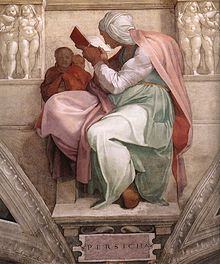Persian Sibyl
The Persian Sibyl is one of those named after Varro , a Roman writer of the 1st century BC. BC , ten sibyls differentiated from lactance , each provided with a geographical epithet .
Other sources from Greek and Roman antiquity contain no references to a sibyl, particularly from geographical regions that were then understood as Persia . Possibly the naming of a sibyl as Persian is to be understood in general as recognition of the long tradition of seerism in these regions, especially since in later times this sibyl is often referred to as the Babylonian or Chaldean sibyl. The "prophecies" she spreads are also often assumed to be of a particularly old age.
Since Persian satraps have long exerted an influence on Asia Minor, it can be assumed that the understanding of prophecy and dream interpretation , which has been developed since prehistoric times in Persian centers such as Babylon , encountered the honor of female seerism in Asia Minor and, from there, also became a term in the Hellenistic region .
Based on lactance, the Christian Middle Ages and the Renaissance understood the Persian Sibyl as a pagan herald of an expectation of God, almost on a par with the prophets .
In Gothic and Renaissance art, the Persian sibyl is usually depicted as one in a series of sibyls, based on Varro, often in contrast to an often equal number of prophets of the Old Testament.
Probably the best-known pictorial representation is Michelangelo's Persica in the fresco on the ceiling of the Sistine Chapel , where a total of five sibyls alternate with seven prophets. She is shown as an old woman, the oldest of the Sibyls there.
Further representations of a Persian Sibyl are u. a. found in the following locations:
- Ulm , Gothic half-sculpture in the choir stalls of the cathedral, as one of ten sibyls, in the total work of art with numerous ancient scholars and prophets
- Rome , Church of Santa Maria del Popolo, as one of the four Sibyls of Pinturicchio
Web links
Individual evidence
- ^ Des Lucius Caelius Firmianus Lactantius writings . Translated from Latin by Aloys Hartl. (Library of the Church Fathers, 1st row, Volume 36) Munich 1919. Chapter 5
- ↑ See also The Persian Sibylline oracle and related Zoroastrian works . In: B. Spuler, M. Boyce (Ed.): Handbuch der Orientalistik . Vol. 3. Leiden 1991, ISBN 90-04-09271-4 , pp. 371ff.
